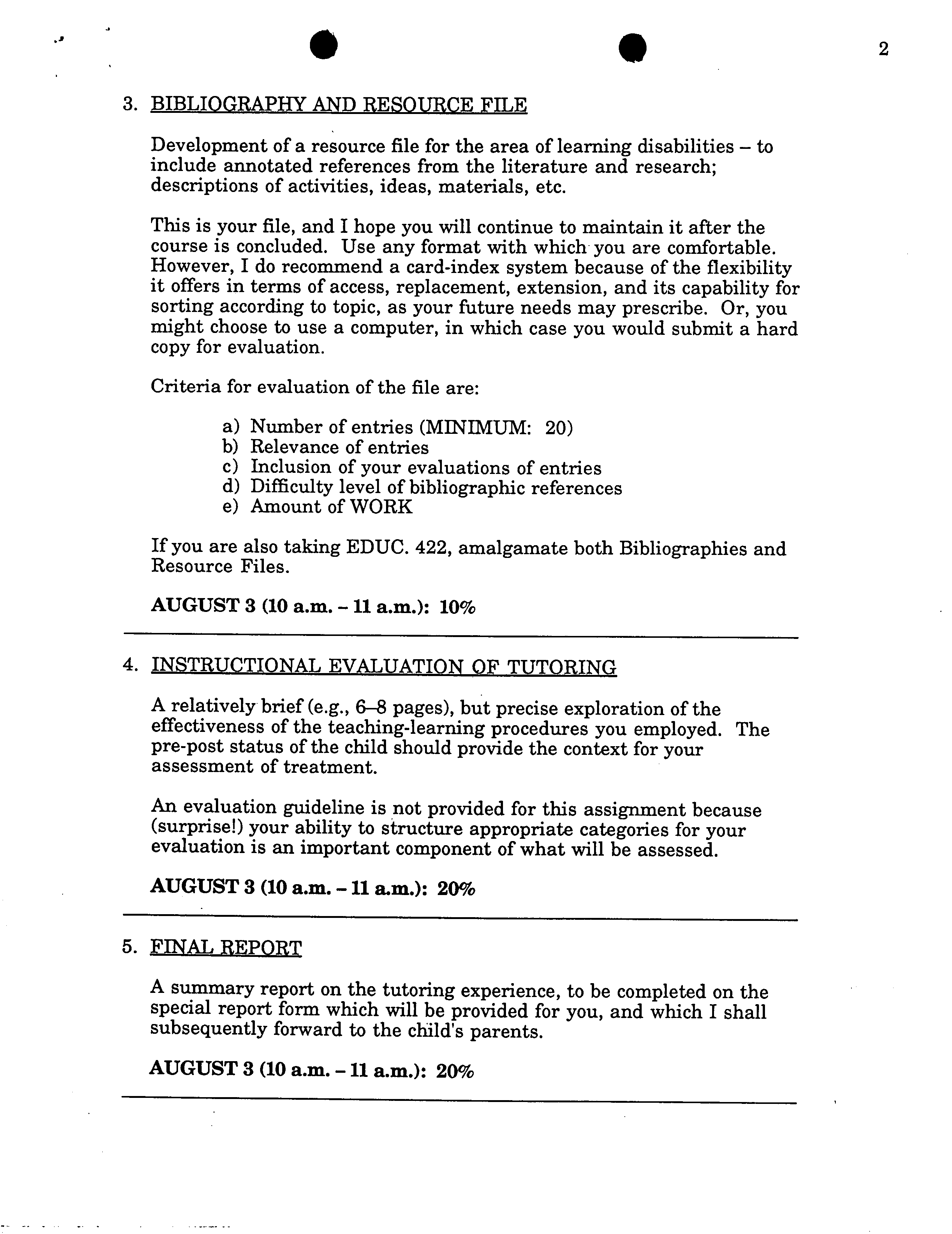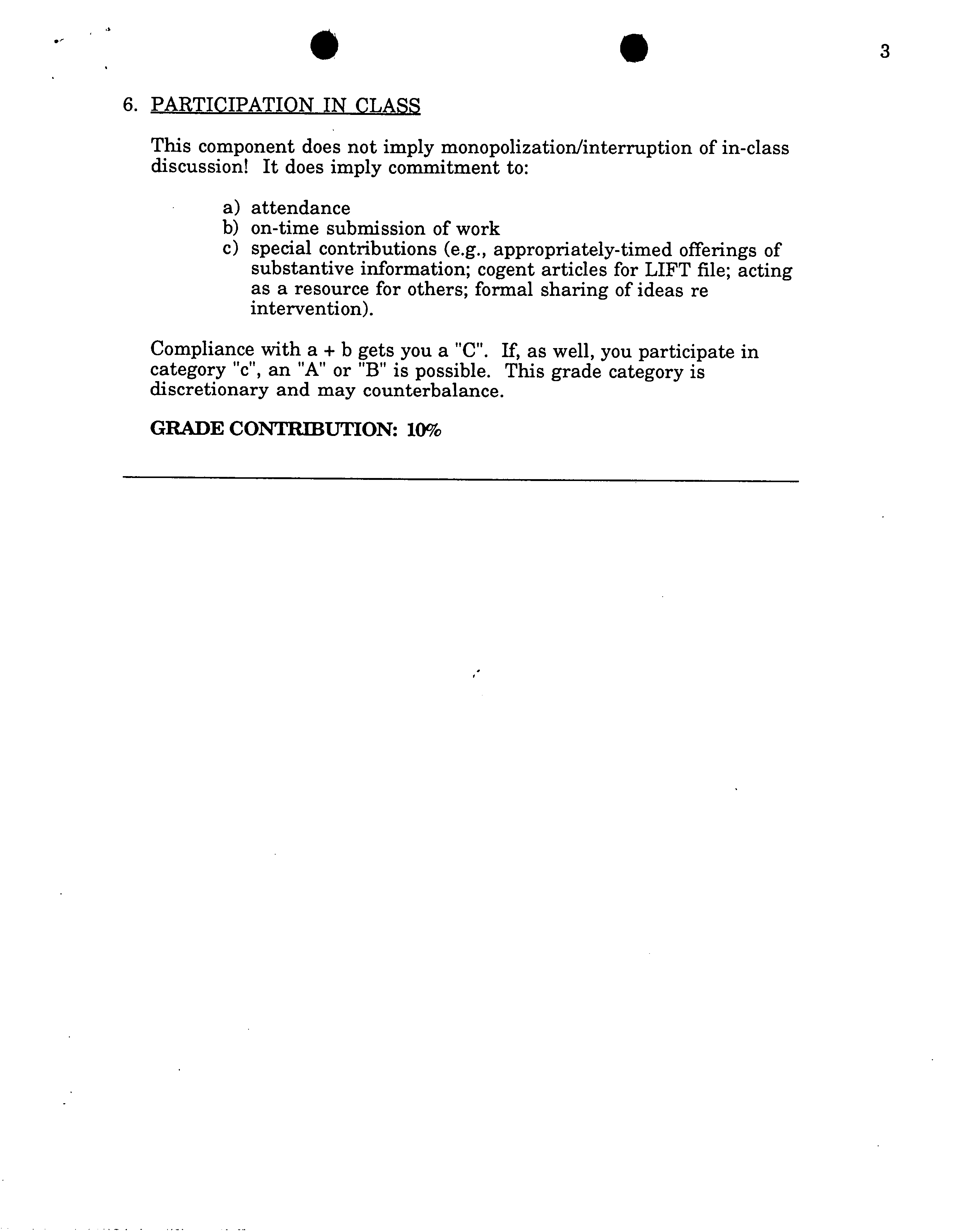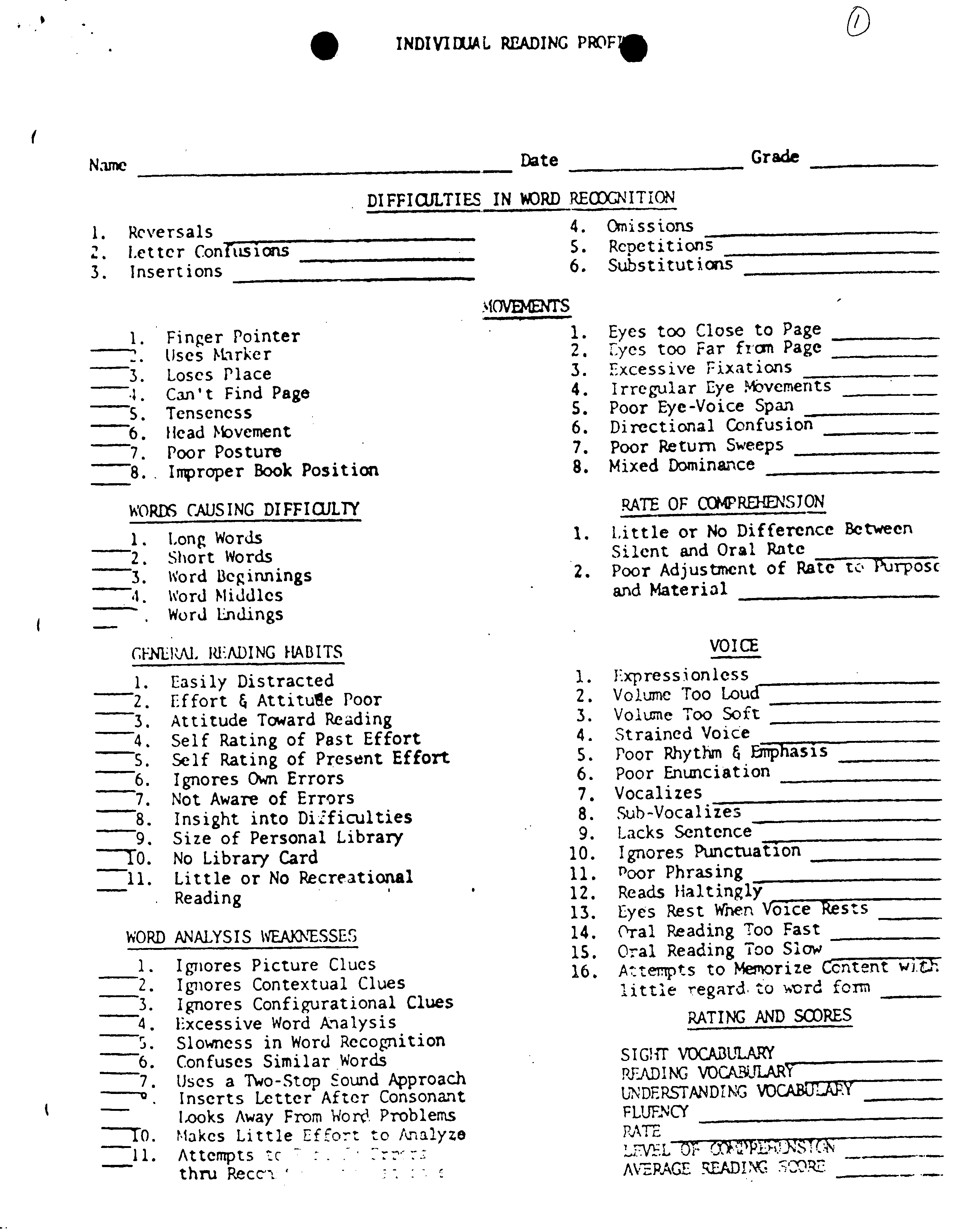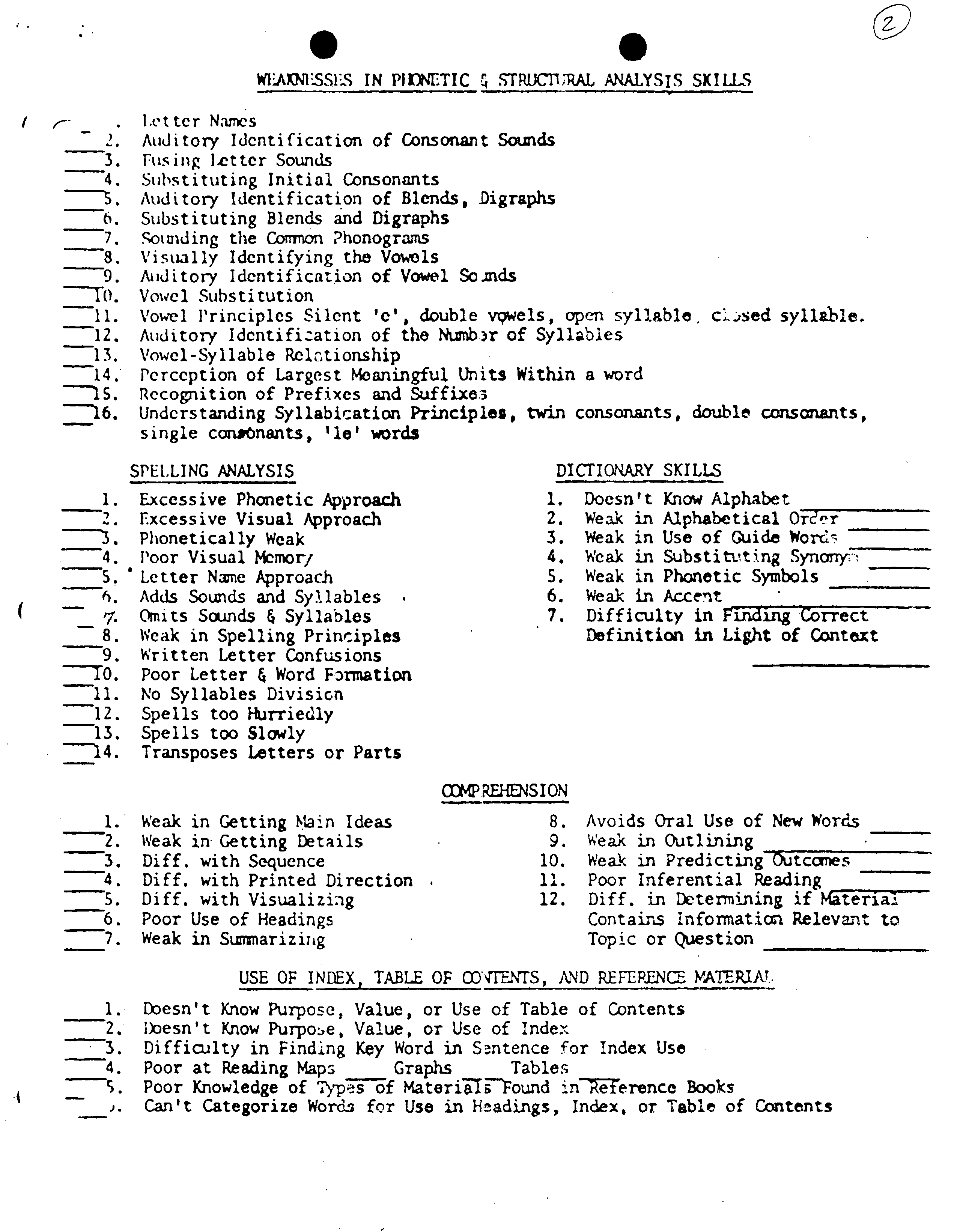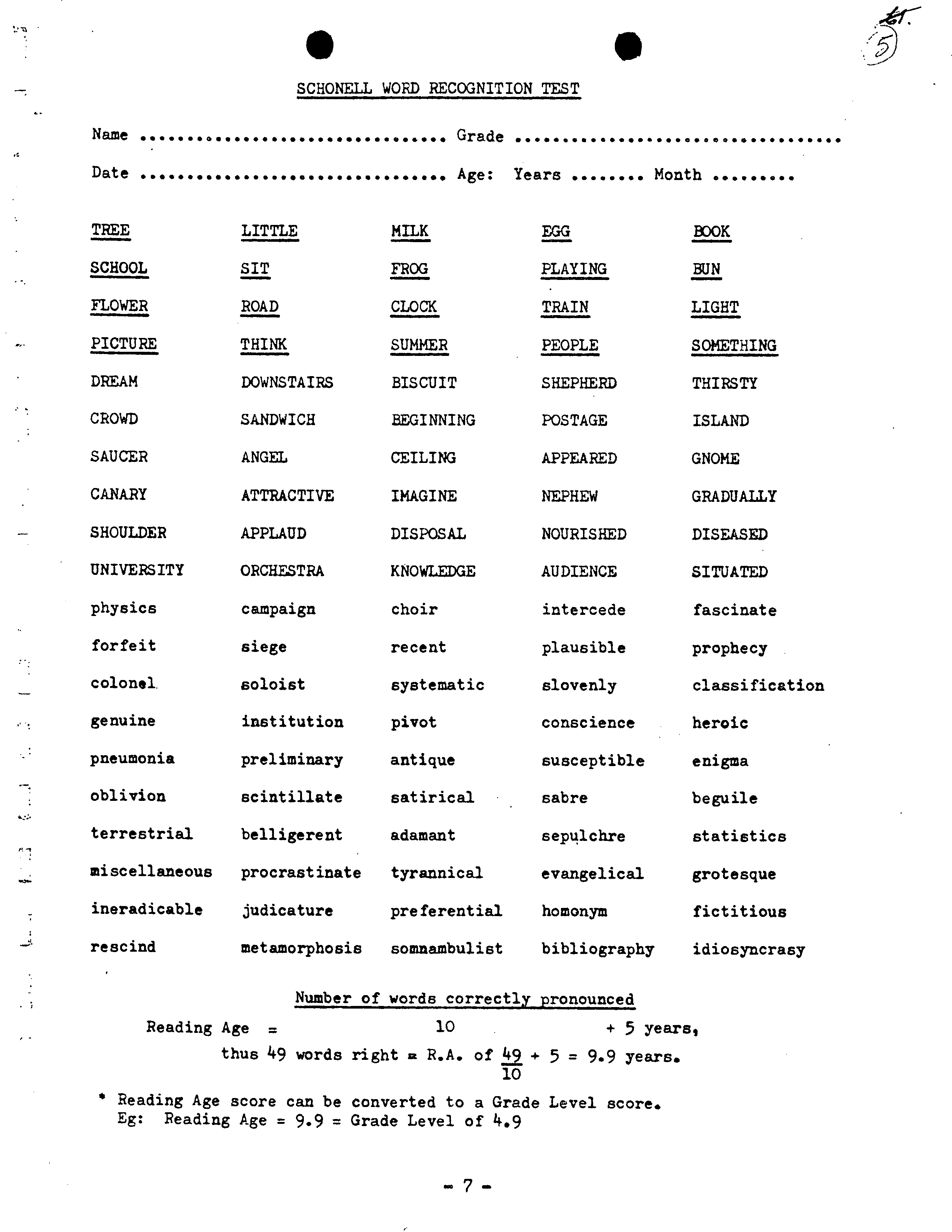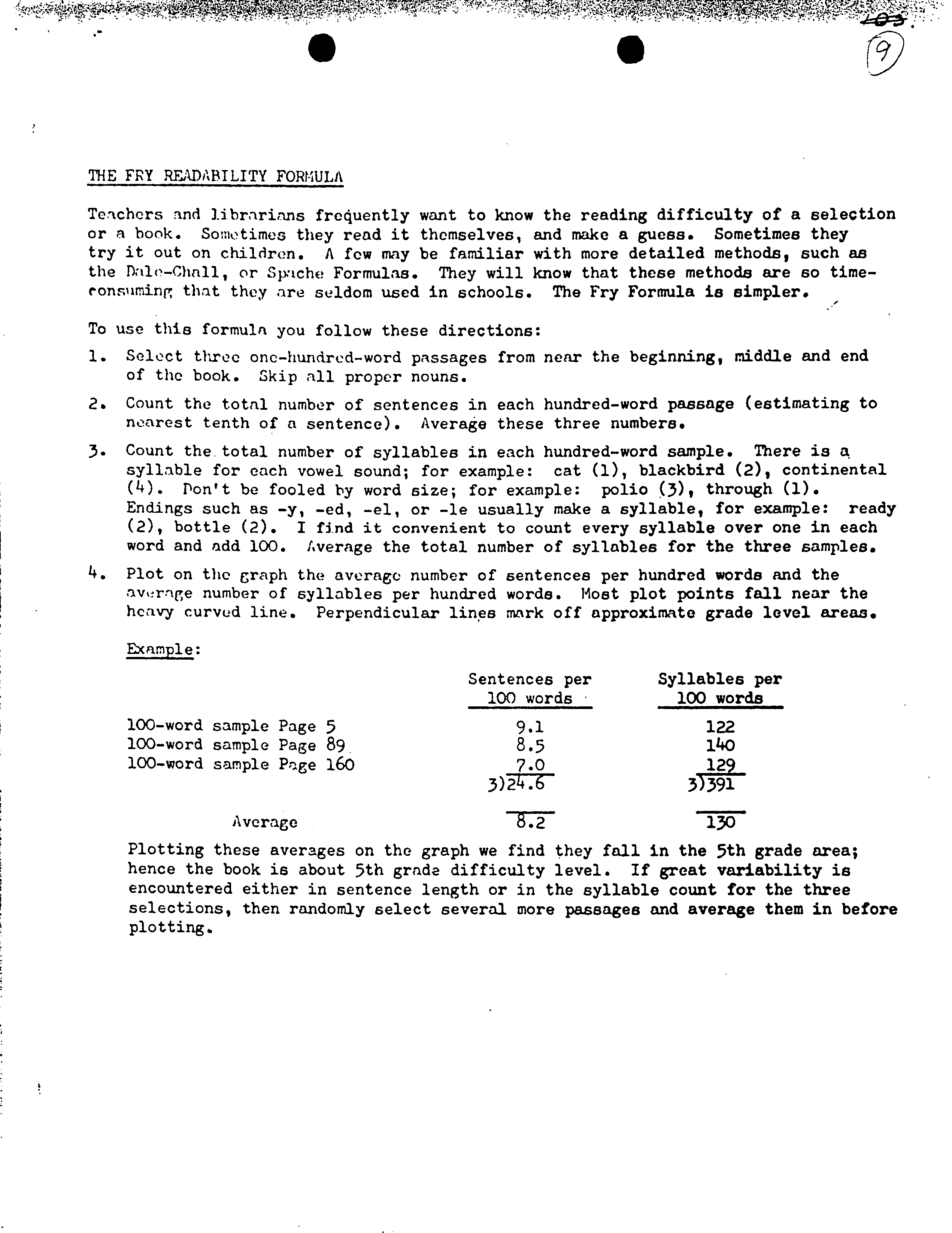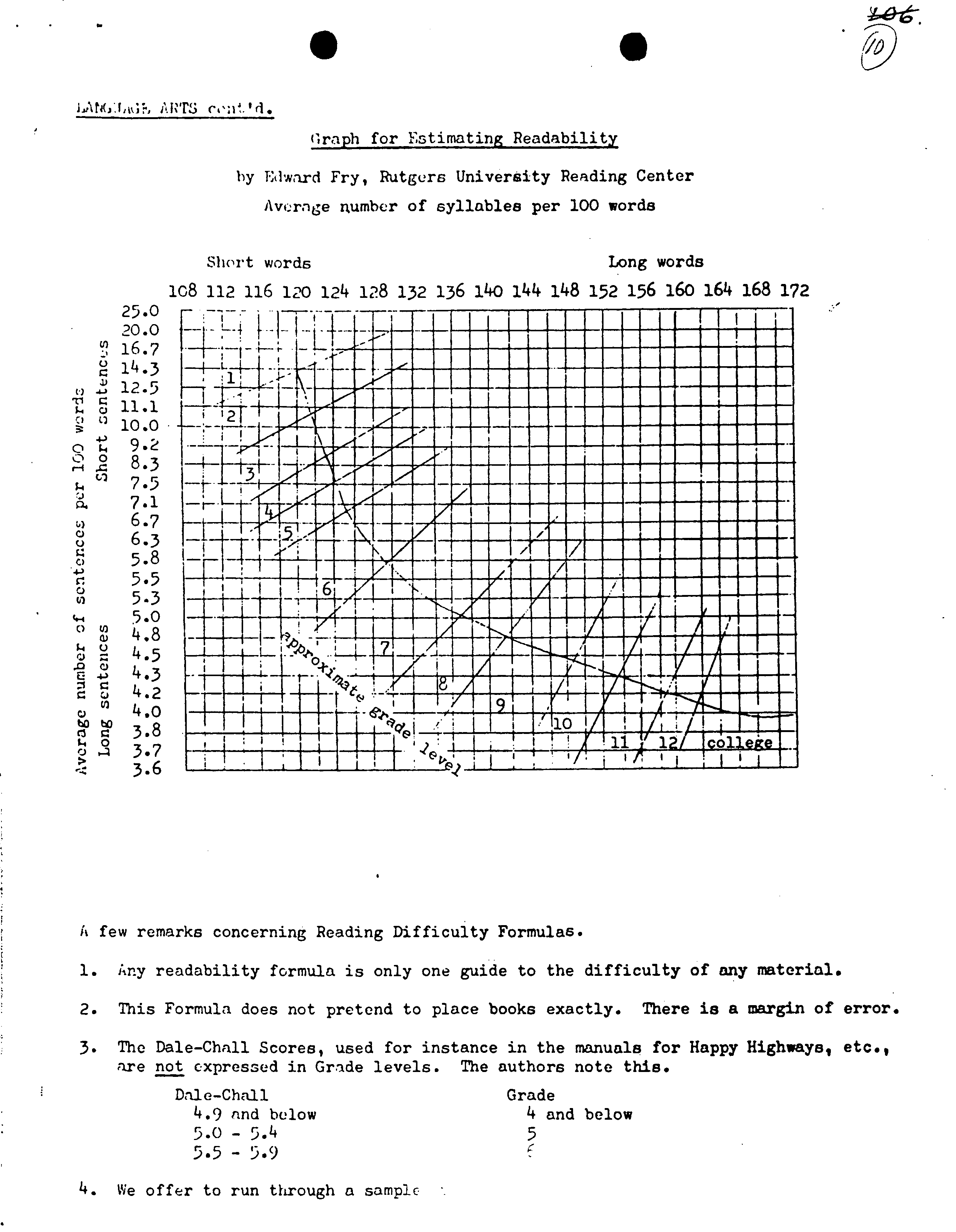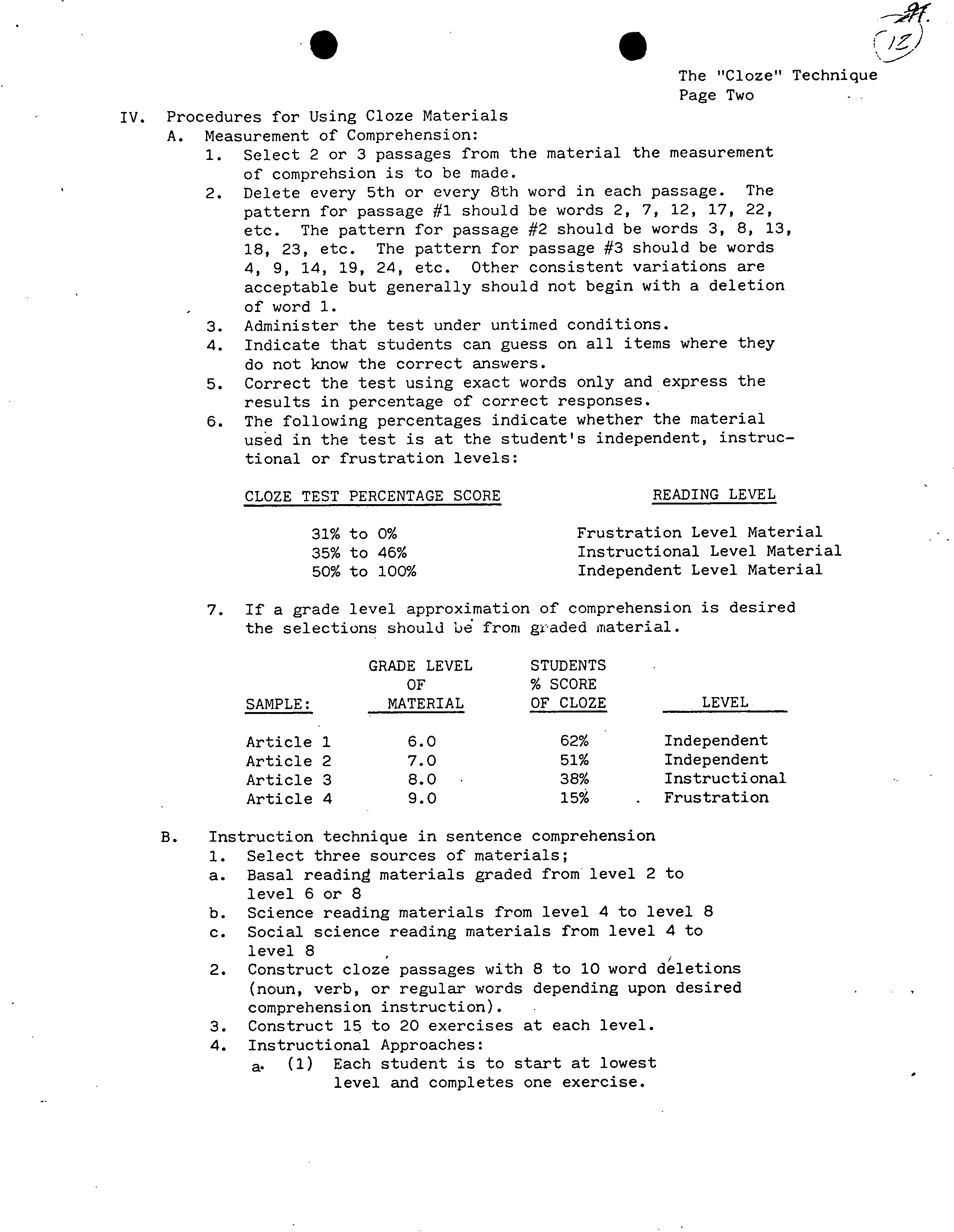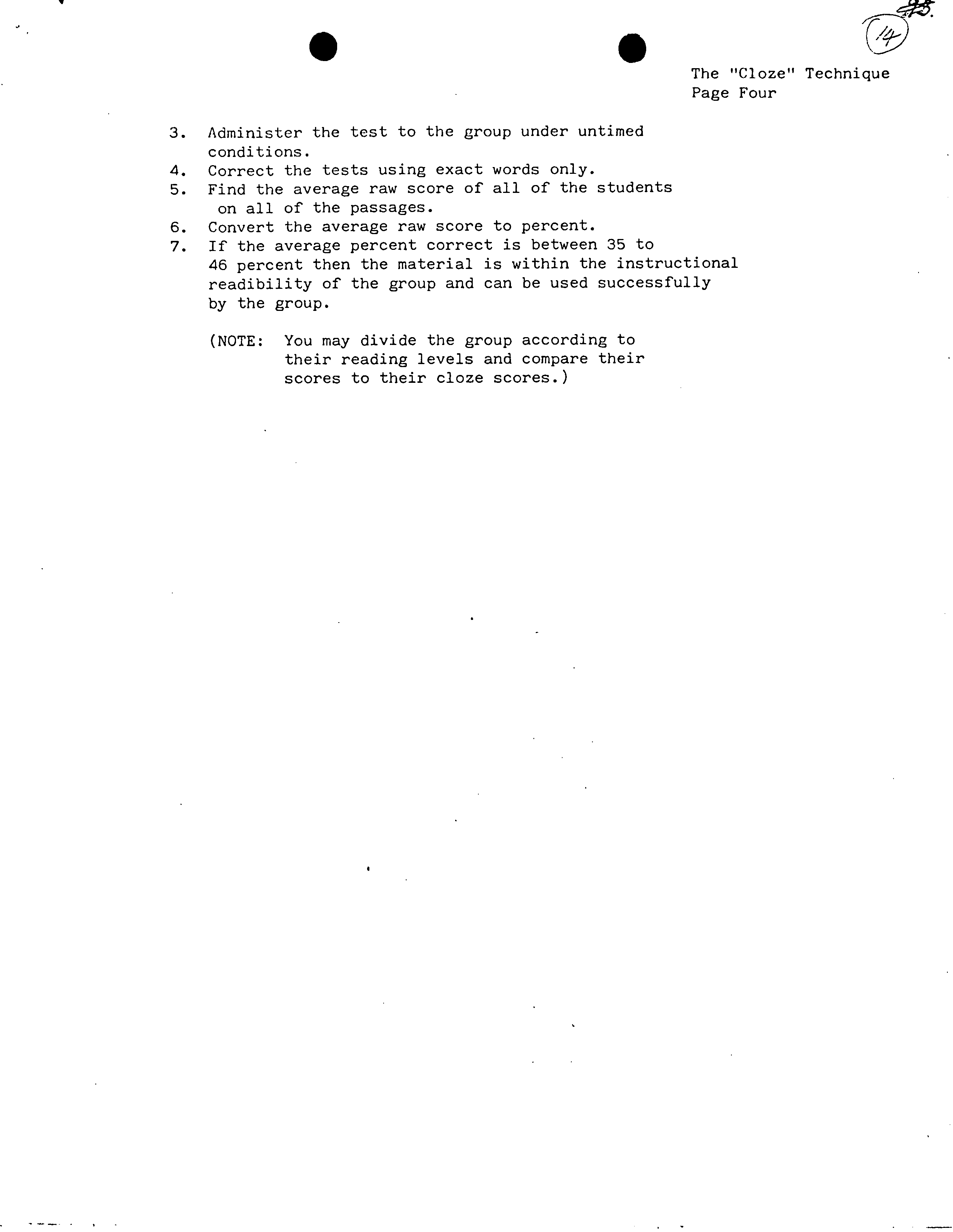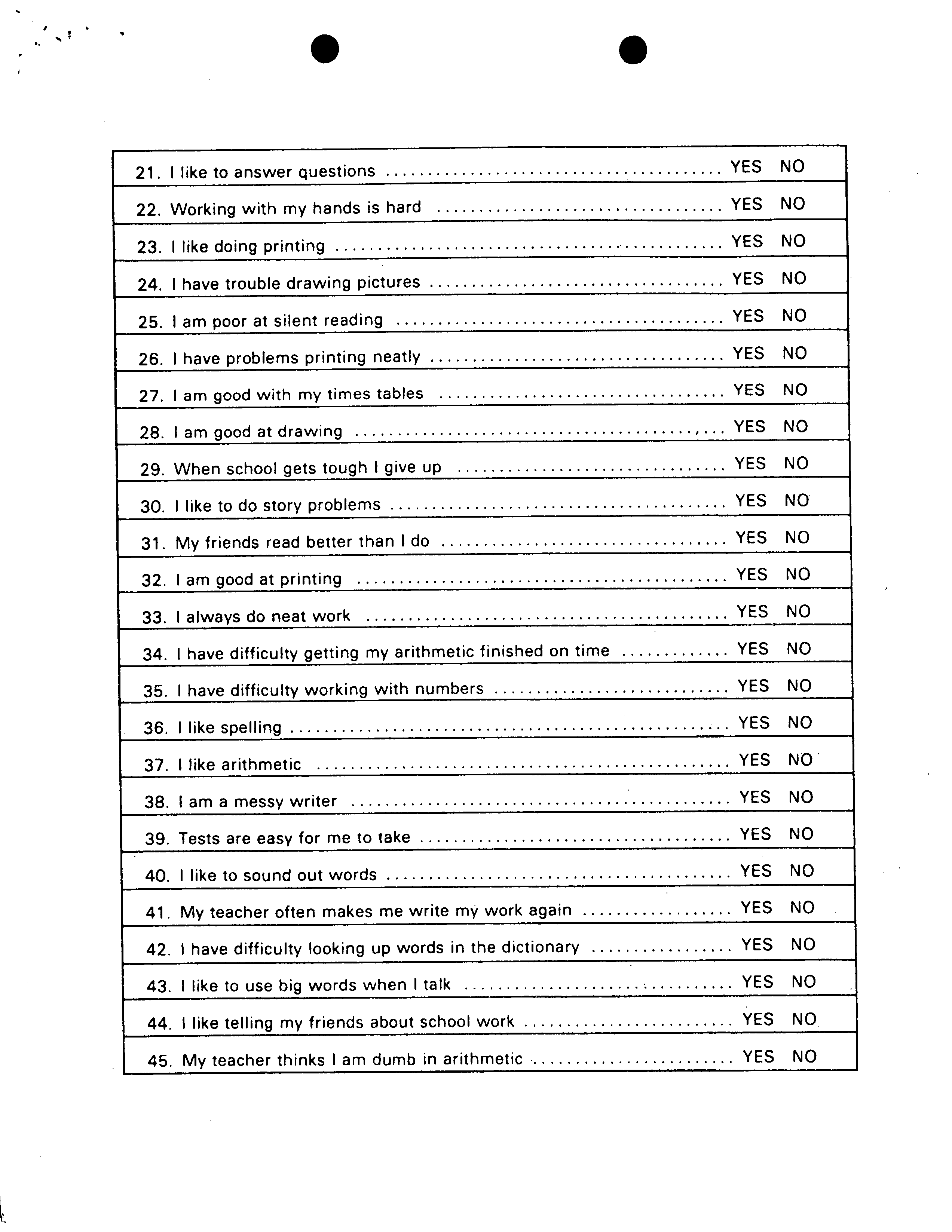0
Simon Fraser University
EDUCATION 424-4
Learning Disabilities: Laboratory
Summer Session, 1990
?
Instructor: Sharlene Lazin
(July 3- August 10)
Tuesdays / Thursdays
1:00 - 4:50 p.m.
Location: MPX 7506
PREREQUISITE:
Education 422
COURSE OUTLINE:
Through a tutorial emphasis, this course will provide:
1.
An understanding of the educational difficulties encountered by learning
disabled students.
2.
Information about assessment, teaching methods and learning strategies.
3.
Practical experience with initial and on-going assessment and the
development of remedial programs.
4.
An examination of various methods of reporting and record keeping.
Assignments include reports on assessment and tutoring. There is no exam.
Details will be provided at the first class meeting.
ASSIGNMENTS:
(1) Initial Assessment of Tutee (Testing and report) -- 20%
(2) Critical Evaluation of a selected instructional approach with reference to its
suitability for LID students (5-9 pg. research essay) -- 20%
(3) IEP (Individualized Education Plan) for tutee, based upon initial assessment --
20%
(4) Instructional Evaluation of Tutoring, to include:
(a)
Report on the effectiveness of teaching/tutoring strategies used during
program
(b) Self-evaluation
(C)
Portfolio containing samples of materials, methods used, with explanatory
comments -- 30%
(5) Final Report to Parents -- 10%
REQUIRED TEXT:
Mann, P. H., Suiter, P. A., McClung, A. H. Handbook in Diagnostic Teaching.
Allyn & Bacon.
. ?
.1
?
1
EDUCATION 424-4: 1990-2
ASSIGNMENTS
1.
INITIAL ASSESSMENT
An evaluation of the current status of your student in a specific area of
learning. A report embracing:
General evaluation of child (subject)
Selection of tests
Conditions of testing
Scores
Interpretation of scores
The major purpose of this assignment is to establish a platform for the
treatment you design for the student.
Refer: evaluation-category-sheet for criteria to be used in evaluation
of your report.
JULY 10: 20%
2.
INDIVIDUAL EDUCATION PLAN (JEP)
The IEP is the master plan of what you, the teacher, decide to do
regarding the treatment of the child., It will specify:
- skills/concepts to be developed
- instructional strategies to be employed
- materials to be used
- amount of tutoring time contracted
Warrants for your decisions will be derived from the Initial Assessment;
and IEP entries should link to the information gained by assessment.
The [EP FORM will be distributed on June 29.
Criteria for evaluation of the IEP are:
a)
That it be correct and complete.
b)
Specificity of content.
c) Feasibility of plan.
d)
That the content be logical and consistent.
e)
Overall appearance of the document.
July 17: 200/c
.
?
I
3. BIBLIOGRAPHY AND RESOURCE FILE
Development of a resource file for the area of learning disabilities - to
include annotated references from the literature and research;
descriptions of activities, ideas, materials, etc.
This is your file, and I hope you will continue to maintain it after the
course is concluded. Use any format with which you are comfortable.
However, I do recommend a card-index system because of the flexibility
it offers in terms of access, replacement, extension, and its capability for
sorting according to topic, as your future needs may prescribe. Or, you
might choose to use a computer, in which case you would submit a hard
copy for evaluation.
Criteria for evaluation of the file are:
a)
Number of entries (MINIMUM: 20)
b)
Relevance of entries
c)
Inclusion of your evaluations of entries
d)
Difficulty level of bibliographic references
e)
Amount of WORK
If you are also taking EDUC. 422, amalgamate both Bibliographies and
Resource Files.
AUGUST 3 (10 a.m. —11 a.m.): 10%
4. INSTRUCTIONAL EVALUATION OF TUTORING
A relatively brief (e.g., 6-8 pages), but precise exploration of the
effectiveness of the teaching-learning procedures you employed. The
pre-post status of the child should provide the context for your
assessment of treatment.
An evaluation guideline is not provided for this assignment because
(surprise!) your ability to structure appropriate categories for your
evaluation is an important component of what will be assessed.
AUGUST 3 (10 a.m. —11 am.): 20%
5.
FINAL REPORT
A summary report on the tutoring experience, to be completed on the
special report form which will be provided for you, and which I shall
subsequently forward to the child's parents.
AUGUST 3 (10 a.m. —11 a.m.): 209o
'
2
.
?
.
6. PARTICIPATION IN CLASS
This component does not imply monopolization/interruption of in-class
discussion! It does imply commitment to:
a) attendance
b) on-time submission of work
c)
special contributions (e.g., appropriately-timed offerings of
substantive information; cogent articles for LIFT file; acting
as a resource for others; formal sharing of ideas re
intervention).
Compliance with a + b gets you a "C". If, as well, you participate in
category "c", an "A" or "B" is possible. This grade category is
discretionary and may counterbalance.
GRADE CONTRIBUTION: 100/c
3
INDIVIW.AL READING
?
0
Name
?
?
Date
?
Grade
DIFFICULTIES IN WORD .REWGNIT10N
1. ?
Reversals
4. Ornissions
2. ?
Letter
ConTiionS
S.
RepetitionS
3.
?
Insertions
6.
Substitutions
Mors
I.
Finger Pointer
1.
Eyes too Close to Page
Uses ftrker
2.
Eyes too Far from Page
3.
Loses Place
3.
Excessive Fixations
4.
Can't Find Page
4.
Irregular Eye Movements
S.
Tenseness
5.
Poor Eye-Voice Span
6.
Head Movement
6.
Directional Confusioi
7.
Poor Posture ?
S
7.
Poor Return Sweeps
8.
Improper
Book Position
8.
Mixed Dominance
WORtiS CAUSING
DIFFICULTY
RATE OF C).RD{SJON
1.
Long Words
1.
Little or No Difference Between
2.
Short Words
2.
Silent and Oral Ritc
?
_______
Poor Adjustment of R.atot' Purposc
3.
Word Beginnings
4.
Word Middles
and Material
Word Endings
CFI&R&L
READING HABITS
VOICE
1.
Easily
Distracted
1.
Expressionless
2.
Effort ?
Attitue Poor
2.
Vohnic Too Loud
3.
Attitude Toward Reading
3.
Volume Too Soft
4.
Self Rating of
Past
Effort
4.
Strained Voice
_________________
S.
Self Rating of Present
Effort
5.
Poor Rhythm f
?
phasis
6.
Ignores Own Errors
6.
Poor Enunciation
7. Not Aware of Errors
7.
Vocalizes ?
_____________________
8.
Insight into Diificulties
8.
Sub-Vocalizes
9.
Size of Personal Library
9.
Lacks Sentence
10.
No Library Card
10.
Ignores Punctuation
11.
Little or No Recreational
11.
p
oor Phrasing
Reading
12.
Reads Haltingly
13.
Eyes Rest When Vie Rests
WORD
ANALYSIS WEAKNESSES
14.
(ral Reading Too Fast
15.
Oral Reading Too Slow
1 i ?
ci
16.
________
Attertpts to Memorize
?
ntent wi
2:
Ignores Contextual Clues
"Little regard.
LO
word forti
3.
Ignores Configurational Clues
4.
Excessive Word A-a1ysis
RATING AND SCORES
Slowness in Word Recognition
SIGHT VOCABULARY
6.
Confuses Similar Words
READING VOCABULAR'1
7.
.
Uses a Two-Stop Sound Approach
Inserts Letter After Consonant
__________-
UNDERSTANDING VOCABUIJ'(
__
Looks Away From Worc. Problems
FLUENCY
__
10.
Makes Little Effort to Analyze
PATE
_ll. Attempts ?
c
?
:':
thru Recc ?
-.
AVERAGEREADI
?
X)RE. _____
.
?
.
?
0
WNLSSLS IN PE)NETTC
4
r STRUC'IlJRAL ANALYSIS SKILLS
Letter Names
Auditory Identification of Consonant Sounds
Fusing Letter Sounds
Substituting Initial Consonants
Auditory
Identification
of Blends,
.Digraphs
Substituting
Blends and Digraphs
Sounding the Common Phonograms
Visually Identifying the Vowels
Auditory Identification of Vowel So.znds
Vowel Substitution
Vowel Principles Silent 'c', double vçwels,
open syllable
Auditory Idcntifiation of the Ni.nbr of Syllables
Vowel-Syllable
Rc)tionship
Perception of Largest Meaningful Units
Recognition of
Prefixes and Suffixe3
Understanding Syllabication Principles,
single consonants,
'le' words
I
-
2.
3.
4.
7.
8.
9.
11.
l 2.
13.
14.
-Th.
6.
cased syllable.
Within a word
twin
consonants,
double consonants,
SPELLING ANALYSIS
?
DICTIONARY SKILLS
1. ?
Excessive
Phonetic Approach
?
1. ?
Doesn't Know
Alphabet
2.
?
Excessive Visual Approach
?
2. ?
Weak in
Alphabetical
0i?er
3.
?
Phonetically Weak
?
3. ?
Weak in Use of Guide Worc
4. ?
Poor Visual Mernor, ?
4. ?
Weak
in
Substituting Synorry
S. • Letter Name Approach ?
S. ?
Weak in Phonetic Symbols
(.
?
Adds Sounds and Syllables
?
. ? 6. ?
Weak in
Accent _________________-
7 . ?
Omits Sounds f Syllables
?
7. ?
Difficulty
in
Fiiiding Correct
8.
?
Weak in Spelling Principles ?
Definition in Light of Context
9. ?
Written Letter Confusions
10. ?
Poor Letter
f Word FDrTaation
_ll. ?
No Syllables Division
12.
?
Spells too Hurriedly
13. ?
Spells too Slowly
14. ?
Transposes Letters
or Parts
1. ?
Weak in Getting Main Ideas ?
8. ?
Avoids Oral Use of New Words
2. ?
Weak in Getting Details ?
9. ?
Weak in Outlining
3. ?
Diff. with Sequence
?
10. ?
Weak in PredictingOutces
4. ?
Diff. with Printed Direction
?
I.L. ?
Poor Inferential Reading _________
S.
?
Diff. with Visualizing
?
12.
?
Diff. in Determining if ?'tèria
6. ?
Poor Use of Headings ?
Contains
Information
Relevant to
7. ?
Weak in Summarizing
?
Topic or Question
USE OF INDEX, TABLE
OF QJTEWTS, AND REFE-PENCE
1.
Doesn't
Know
Purpose, Value, or Use of Table of Contents
2.
Doesn't Know Purpoe, Value, or Use of Index
3. Difficulty in
Finding Key Word in Sentence for Index Use
4.
Poor at Reading Maps____ Graphs
?
Tables ____
S. Poor Knowledge of Types of Mater iTPound in Reference Books
Can't Categorize Words for Use in Headings, Index, or Table of Contents
S ?
S
WEPWN AUDITORY DISCRIMINATION TEST
Instructions:
"I am going to say two words. I want you to tell ire whether I say
the sane word twice or whether I say two different words. Try this:
hand - sand. Did I say the sane word twice? You're right, I said
two different words: 'hand' is not the sane as 'sand'. rcti.i try this:
nonth - rionth. You're right, I said the sane word two tiinss. Now
listen to the words I'm going to say and tell ire if they sound the
sane or different. Turn your chair around so you cannot see rre.
I want to see hcii well you can listen.
1.
tub - tug
2.
web - wed
3.
chap - chap
4.
bale - gale
5.
vow - thou
6.
zest - zest
7.
thread - shred
8.
bass - bath
9.
pat ?
pack
10.
coast - toast
11.
cat - cap
12.
lath - lash
13.
clothe
- clove
14.
shack -
sack
15.
king -
king
16.
pork -
cork
17.
shoal
- shawl
18.
par - par
19.
muff - rrn.ss
20.
lease - leash
Score: The child's score, from 0-15, is the nurrber
of errors on dissimilar pairs.
-.
.
?
.
DOLCH BASIC 220 WORD LIST
These 220 words comprise
?
50
68%
of all reading material at the elementary
level.
Pre-Primer
a
and
away
at
big
blue
can
come
down
find
for
funny
go
help
here
I
in
is
it
jump
little
look
make
me
my
not
one
play
red
run
said
see
the
three
to
two
up
we
where
yellow
you
Primer
all
am
are
ate
be
black
brown
but
case
did
do
eat
far
get
good
have
he
into
•1
must
new
no
now
on
our
out
please
pretty
ran
ride
saw
say
she
so
soon
that
there
they
this
too
under
want
was
well
went
what
white
who
Will
with
yes
First Grade
after
again
an
any
as
ask
by
could
every
fly
from
give
going
had
has
his
him
her
how
just
know
let
live
may
of
old
once
open
over
put
round
some
stop
take
thank
them
then
think
walk
were
when
Second Grade
always
around
because
been
before
best
both
buy
call
cold
does
don't
fast
first
five
found
gave
goes
green
its
made
many
off
or
pull
read
right
sing
sit
sleep
tell
their
these
those
upon
us
use
very
wash
which
why
wish
work
would
write
your
Third Grade
about
better
bring
carry
clean
cut
done
draw
drink
eight
fall
far
full
got
grows
held
hot
hurt
if
keep
kind
laugh
light
long
much
myself
never
only
own
pick
seven
shall
show
six
small
start
ten
today
together
try
warm
Instructional Level
Primer
ere-r1mer
?
-
-10
8
errors
errors
or
or
less
less
±r-Et
Grade ?
8
errors or less
c
Grade -9 errors or less
ade
-.8
errors or less
•
-
?
SCHONELL WORD RECOGNITION TEST
Name •••............................. Grade
Date •••••••••••••...••.............•. Age: Years ........ Month
TREE
SCHOOL
FLOWER
PICTURE
DREAM
CROWD
SAUCER
CANARY
SHOULDER
UNIVERSITY
physics
forfeit
colonel.
genuine
pneumonia
oblivion
terrestrial
miscellaneous
ineradicable
rescind
LITTLE
SIT
ROAD
THINK
DOWNSTAIRS
SANDWICH
ANGEL
ATTRACTIVE
APPLAUD
ORCHESTRA
campaign
siege
soloist
institution
preliminary
scintillate
belligerent
procrastinate
judicature
metamorphosis
MILK
FROG
CLOCK
SUMMER
BISCUIT
BEGINNING
CEILING
IMAGINE
DISPOSAL
KNOWLEDGE
choir
recent
systematic
pivot
antique
satirical
adamant
tyrannical
preferential
somnambulist
EGG
PLAYING
TRAIN
PEOPLE
SHEPHERD
POSTAGE
APPEARED
NEPHEW
NOURISHED
AUDIENCE
intercede
plausible
slovenly
conscience
susceptible
sabre
sepulchre
evangelical
homonym
bibliography
BOOK
BUN
LIGHT
SOMETHING
THIRSTY
ISLAND
GNOME
GRADUALLY
DISEASED
SITUATED
fascinate
prophecy
classification
heroic
enigma
beguile
statistics
grotesque
fictitious
idiosyncrasy
Number of words correctly pronounced
Reading Age =
? 10
?
+
5
years,
thus
49
words right st R.A. of
4
9 +
5
=
9.9
years.
10
* Reading Age score can be converted to a Grade Level score.
Eg: Reading Age
=
9.9
= Grade Level of
4.9
7—
•
?
O
ROSW1L-CiiALL TEST - PUPIL S1-SE RECORD
Each iten on
the Pcswl1-Ch&ll
should be printed on a separate note card.
It is
these note cards the student
is given to
road.
Letters & Consonant Blends
c ?
h
?
b
(a)
Have the student name each
s ?
p ?
m
letter (code-N)
i
?
n ?
k ?
j ?
w ?
z -
(5)
Have the student
recite the sund
d ?
1 ?
1 ?
v
?
y
t
each letter has
(code-s
g
ch
?
fl
?
th ?
at ?
tr
(c)
Have the student
say
a word that
begi.ns
with each
lett ?
(code-W)
cr
?
sh
?
wh ?
str ?
scr
II
Name the words
Write
down student respo
nse.
let ?
rim ?
nap
?
sot ?
hut
sip
?
rr.d ?
tub ?
beg ?
mob
-
Read
He
took
the
a
sentences
sip of milk from the tot
cj
f the
jug.
sam
let A
l
aim
take a nap on the
cot in the
hut.
What do
these
le
t
ters sav
-
?
Probe the
student
for both a
long
and
short sound of the
vowee
(a)
Code
?
short sound S
i ?
0 ?
9 ?
U ?
C
Code -
long sound I
III
Read the words
Write
down
student
response (III
?
IV
?
or V)
If
student misses
three iten
go
to
the
next
section
pin ?
cut ?
dim ?
mat ?
rob
pine ?
cute
?
dime ?
mate
?
robe
-
1V
Read the words
Write
down student reeponse
seek ?
pail
?
coast ?
harm
good
?
yawn
bout
gain ?
boil ?
load ?
cart
nor ?
fern
cool
meal
?
coin ?
leaf ?
peel
haunt ?
curl
firm
V
Read
the words
Write
down 8tudnt
response
daytime
?
overcome
invented
enjoyment ?
expansion
ccntribt cn
departmental ?
permanently
WIDE
RANGE
WORD LIST
1. ?
Before administration print each letter and each word up
till
the end of
the
3rd row of words on individual cards.
?
It is these cards
the student
is given
to read...
2. ?
Each
correctly read letter or
word counts as
one point.
The
test is
discontinued when
3
word sequentially are missed.
3. ?
With
intermediate
age students begin with the first word
and
give the
student
25
points
bonus for scoring purposes.
A
R ?
Z ?
H
I ?
Q
?
S
E
B
?
0
10
A ?
B
?
0 ?
S ?
E ?
P
T
?
H
?
P
I ?
U
?
Z
?
Q
25
Level 1
cat
?
see
?
red
?
to ?
big
work ?
book
eat ?
was
him ?
how
36
then ?
open
?
letter
jar
?
deep
even
?
spell
awake ?
block
size
46
weather
should ?
lip
finger ?
tray ?
felt ?
stalk
cliff ?
lame
struck
56
approve
plot
?
huge
quality
sour
?
imply
?
humidity
urge
61+
bulk
exhaust
abuse
collapse
glutton
clarify
70
recession
threshold
horizon
residence
participate
quarantine
76
luxurious
rescinded
emphasis
aeronautic
intrigue
repugnant
82
putative
endeavor
heresy
discretionary
persevere
anomaly
88
rudimentary ?
miscreant
usurp
novice
audacious
mitosis
94
seismograph
spurious
idiosyncrasy
?
itinerary
pseudonym
aborigines
?
100
* *•* * *
Level 1 -
Reading - Grade Norms
Score Grade
Score Grade
Score Grade
Score Grade
?
Score Grade
Score Grade
?
Score Grade
6475
3
2
1 ?
?
?
?
?
?
?
Pk-7
Pk,4Pk.5Pk.2
Pk.1
N.8N.5
1
16_17
9-20
23
22
21
18
?
Gr.1.0Kg.9Kg.8Kg.6Kg.71.1
42-+3
39-40
36...37
1+1+
41
38
?
?
?
?
?
?
2.42.3
2.1
2.2
2.01.0
5856575553
54
??
????
4.1
3.93.63.83.53.3
71
7069676866
??????
6.35.9
6.1
5.75.55.3
84
8283
81
7080
9.7
9.38.78.49.0
8.1 ??????
97969592
91+
93
14.9
14.5
14.1
13.7
12.9
13.3
8
24-25
?
1.2
45-46
?
2.5
59 ?
4.2
72 ?
6.5
85
10.1 ?
98
15.4
Kg.9
26-27
?
1.3
1+7 ?
2.6
60 ?
4.4
73 ?
6.7 86
10.5 ?
99
15.8
9
?
Kg.1
28-29
?
1.4
48
?
2.7
61 ?
4.5
74 ?
6.8
87
10.9
?
100
16.2
13-14
10-11
15
12
Kg.4
K
Kg.5Kg.2
g-3
32-3330-3135
34
????
1.81.71.61.5
52
51
5049
?
?
?
?
3.1
3.02.9
2.8
65
61+
6362
????
5.1
4.85.04.7
78777576 ??
?
?
7.87.57.27.0 91
9089
88
12.5
12.1
11.7
11.3
S ?
S
fe '$-rVArUVV.Q1
DIPTIO FOR DIAGNOSTIC SPELLING TES
Give
Lint I to 'my pupil bse plct is ec*d or third ra&.
Give List a to any pupil vboe p1$Cs
t
is
nbO'S
Grade 3,
Grade Scorti2. Lint 1:
M1.aw secoad çrMe
8eDV
15 correCt
?
Second Grads
15-22
?
Third Grade
23:_ 29
Any
pupti
who
score. &
Wye
29
.hou14 be given
the
List 2 tt
Cr.4s 5ortg List 2:
a.Lov thud grad.
5eloV 9 correCt
?
Thtrd Grad.
9,- 19 CoTrect
Puth
Grads
20 - 25
?
Ptft'
(T&dC
26 - 29
?
sixth CredO or better
Over 29 correct
Any pupil who score bsInv 9 ebould be given the Itat I test.
DIAGQSTIC SPELLING TESS
List
Like
CO
aftsv
not
whit
but
those
get
down
phOM
tilt
t,uch
man•
good
sing
boat
?
•
will
vould
train
happy
pretty
time
kept
List 2
biting
ca*'t
study
doesn't
uth.
shoot
jped
dart'
brought
stood
j
ht
ump
ing
darker
darkest
third
hitting
eft.rrtoOit
laugh
each
ito
t4.nth4T
bcsusc
through
r
.
THE FRY READABILITY FORMULA
Teachers and librarians frequently want to know the reading difficulty of a selection
or a hook. Sometimes they read it themselves, and make a guess. Sometimes they
try it out on children. A few may be familiar with more detailed methods, such an
the Dalc'-Chn1l, or Spache Formulas. They will know that these methods are so time-
ronsuming that they are seldom used in schools. The Fry Formula is simpler.
To use this formula you follow these directions:
1. Select three one-hundred-word passages from near the beginning, middle and end
of the book. Skip all proper nouns.
2. Count the total number of sentences in each hundred-word passage (estimating to
nearest tenth of a sentence). Average these three numbers.
3.
Count the, total number of syllables in each hundred-word sample. There is a•
syllable for each vowel sound; for example: cat (1), blackbird (2), continental
(1+). Don't be fooled by word size; for example: polio (3), through (1).
Endings such as -y, --ed, -el, or -le usually make a syllable, for example: ready
(2), bottle (2). I find it convenient to count every syllable over one in each
word and add 100. Average the total number of syllables for the three samples.
1+. Plot on the graph the average number of sentences per hundred words and the
avrage number of syllables per hundred words. Most plot points fall near the
hcavy curved line. Perpendicular lines mark off approximate
grade level areas.
Example:
Sentences per
?
Syllables per
100 words
?
100 words
100-word sample Page
5
?
9.1
?
122
100-word sample Page
89
?
8.5
?
140
100-word sample Page 160
?
7.0
?
129
3)391
Average
?
8.2
?
130
Plotting these averages on the graph we find they fall in
the
5th grade area;
hence the book is about
5th
grade difficulty level. If great
variability is
encountered either in sentence length or in the syllable count for the three
selections, then randomly select several more passages and
average
them in
before
plotting.
. ?
S
it
?
Co .,
I
?
1.
Graph for Estimating Readability
by Edward Fry, Rutgers University Reading Center
?
Averne rjumber of syllables per 100 words
Short words
?
Long words
108 112 116 120
124 128
132
136 l
L
iO 144 148
152 156
16o 164 168 172
25.0
20.0
16.7
C.)
.
4) ,.,
C-
u •'-'
-ri
C.) ?
•
10.0 -
4.)
?
r .-
o
00
s.
.)
?
?
7.5
'
7.1
6.7
C)
o
?
o.3
C) ?
5.
4.)
r.
C)
?
5.5
tol ?
5.3
5.0
C) U)
C) ?
f,
I-iC
C.)
D C.)
04
. ) ?
+.
3
c.
Ct)
?
'+2
C)
3.
hO
C) -
3.7
A few remarks concerning Reading Difficulty Formulas.
1.
Any
readability formula is only one guide
to
the difficulty
of any material.
2.
This Formula does not pretend
to
place books exactly. There is a margin of error.
3.
The Dale-Chall Scores, used for instance in the manuals for Happy
Highways, etc.,
are not expressed in Grade levels. The authors note this.
Dale-Chall ? Grade
+.9 and below ? k and below
5. O
-5. A ?
5
5.5-5.9
+. We offer to run through a sample
EMMq
K !
mop
M
d
I
NN
0
MIN
'
00101011
1
0101
•r4*aaluM1r4IUIuIaRI
•
UVA
IMMIM111r,
MHMWjN"q
200
N
• ?
W2R
•
U
IUIU
Back to top
IUIIIWIIRiVAIII
Back to top
1RIURPA*
MEAN
1RR
MEN
..
.
?
S
THE "CLOZE" TECHNIQUE
I. Definition
A.
"Clozure - one of the principles emphasized by gostalt psychologists,
describing the process by which percepts, memories, actions, etc.
attain stability, viz, the subjective closing of gaps, or completion
of incomplete forms, so as to constitute wholes."
James, Drever - A Dictionary of Psychology, revised
by Harry Wallenstein, Penjuin Books,
Baltimore, 1964,
p.
41.
B.
"The Cloze" procedure is based on the gostalt idea of closure - the
impulse to complete a structured whole by supplying a missing ele-
ment. The test is composed of passages from which certain words
are omitted. The individual taking the test fills in the blanks
left by the missing words. The score comprises the number of
correctly filled spaces."
Strang, Ruth, et. al. The Ihiprovement of Reading,
Fourth Edition, McGraw Hill, New York,
1967,
p.
249-50.
II. Uses
A. Measurement of Comprehension
B.
Instruction Technique in Sentence Comprehension
C. Measurement of Readibility
III. Construction of Cloze Materials
A.
Select reading selection of about 275 to 300 words.
B.
Delete words in a consistent pattern substituting 15 type spaces
in length and treating the spaces the same in punctuation.
1. For measure of comprehension - delete every
fifth or every eighth word. e.g. word 1, 6,
11, etc., or words 1, 9, 17, 25, etc.
2. For instructional techniques -
a.
for factual comprehension - delete every
8th or every 10th noun or every 8th or
every 10th verb.
b.
for relationship comprehension - delete
every 8th or every 10th word.
3. For measurement of readibility - delete every
fifth word.
•
The "Cloze" Technique
Page Two
IV. Procedures for Using Cloze Materials
A. Measurement of Comprehension:
1.
Select 2 or 3 passages from the material the measurement
of comprehsion is to be made.
2.
Delete every 5th or every 8th word in each passage. The
pattern for passage #1 should be words 2, 7, 12, 17, 22,
etc. The pattern for passage #2 should be words 3, 8, 13,
18, 23, etc. The pattern for passage #3 should be words
4, 9, 14, 19, 24, etc. Other consistent variations are
acceptable but generally should not begin with a deletion
of word 1.
3.
Administer the test under untimed conditions.
4.
Indicate that students can guess on all items where they
do not know the correct answers.
5.
Correct the test using exact words only and express the
results in percentage of correct responses.
6.
The following percentages indicate whether the material
used in the test is at the student's independent, instruc-
tional or frustration levels:
CLOZE TEST PERCENTAGE SCORE
?
READING LEVEL
31% to 0% ?
Frustration Level Material
35% to 46%
?
Instructional Level Material
50% to 100% ?
Independent Level Material
7.
If a grade level approximation of comprehension is desired
the selections should b from graded material.
GRADE LEVEL
STUDENTS
OF
% SCORE
SAMPLE:
MATERIAL
OF CLOZE
LEVEL
Article 1
6.0
62%
Independent
Article 2
7.0
51%
Independent
Article
3
8.0
38%
Instructional
Article
4
9.0
15%
Frustration
B. ?
Instruction technique in sentence comprehension
1. Select three sources of materials;
a.
Basal reading materials graded from level 2 to
level 6 or 8
b.
Science reading materials from level 4 to level 8
c.
Social science reading materials from level 4 to
level ?
/
2. Construct doze passages with 8 to 10 word deletions
(noun, verb, or regular words depending upon desired
comprehension instruction).
3. Construct 15 to 20 exercises at each level.
4. Instructional Approaches:
a .
(1) Each student is to start at lowest
level and completes one exercise.
. ?
.
The
uClozeI
?
Technique
Page Three
(2)
The student corrects his exercise
with a student's key that contains
only correct words.
?
The student
converts score to percentage.
(3)
The teacher discusses exercise with
student and re-corrects with teacher's
key that also contains synonyms that
are acceptable without changing the
meaning.
(4)
Criterion for passing from level to
level
(a) ?
2 errors or 96% correct - accord-
ing to instructor's correction.
(b) ?
If after 5 tries the student did
not make 96% correct - he moves
to the next level of materials
automatically.
b. ?
(1)
Each student is to start at the lowest
level and completes one exercise.
?
(The
exercises should have the deleted words
in mixed up order at the bottom of the
exercise.)
(2)
The student should be instructed to
decide upon a word to complete the
blank and then check the mixed-up list
at the bottom of the e*ercise to see
if the word is there. ?
If it is not,
the student should re-read and decide
upon another word.
(3)
The student corrects his exercise with
an exact word key and converts the score
to percentage.
(4)
Criterion for passing from level to level
(a) ?
2 errors or 96% correct on two
consecutive passages at one level.
(b) ?
If after 5 tries the student did
not make 96% correct on two con-
secutive passages - he moves to
the next level automatically.
c. Distribute the same doze passages to a small group
and discuss each word in relation to its sentence
clues, context clues, etc.
C. ?
Measurement of Readibility
1.
Select 6 to 9 passages from the material that you wish to
measure the readibility of.
2.
Construct a fifth word deletion pattern.
. ?
.
The "Cloze" Technique
Page Four
3.
Administer the test to the group under untimed
conditions.
4.
Correct the tests using exact words only.
5.
Find the average raw score of all of the students
on all of the passages.
6.
Convert the average raw score to percent.
7.
If the average percent correct is between 35 to
46 percent then the material is within the instructional
readibility of the group and can be used successfully
by the group.
(NOTE: You may divide the group according to
their reading levels and compare their
scores to their doze scores.)
STUDENT'S PERCEPTION OF ABILT' SCALE
Frederic J. Boersma and James W. Chapman
Name
?
Birth Date
Boy
?
Girl _____
?
Grade _____
?
School
IMPORTANT DIRECTIONS FOR MARKING ANSWERS
Use black soft lead pencil only.
Circle each answer completely.
Erase clearly any answer you wish to change.
Make no stray marks on this answer sheet.
Answer each item Yes or No.
DO NOT MARK BELOW THIS LINE
STUDENT I.D.
Cot
?
12 ?
34
SEX
GRADE
AGE IN MONIHS
?
78
L91
© 1977 Frederic J. Boersma and James W. Chapman
?
All Rights Reserved
.
DIRECTIONS
This booklet has a list of statements about how you feel about school. Some of these are
true and some are not. Circle the YES if the statement is usually true of you. Circle the NO
if the statement is not usually true of you. Read each question carefully and answer every
item, even if it is hard to decide which answer is most like you. Do not circle both YES and
NO. Just circle one answer for each statement. This is not a test so there are no right or
wrong answers. Please mark exactly how you really feel inside about school.
1.
I always understand everything I read
?
..............................
YES
NO
2.
My school work
?
is usually untidy
?
..................................
YES
NO
3.
All new words are easy for me to spell
?
.............................
YES
NO
4.
I find it hard to understand what I have to do
?
.......................
YES
NO
5.
I think my school work is really good
?
...............................
YES
NO
6.
I usually have problems understanding what I read
?
.................
YES
NO
7.
I am one of the smartest kids in the class
?
..........................
YES
NO
8.
I
?
have ?
neat ?
printing
?
...............................................
YES
NO
9.
I ?
usually finish
?
my schoolwork ?
....................................
YES
NO
10.
I am
?
unhappy with
?
how I
?
read ?
.....................................
YES
NO
11.
I ?
like
?
reading ?
.....................................................
YES
NO
12.
My ?
printing
?
is ?
perfect ?
..............................................
YES
NO
13.
I ?
am ?
good ?
at ?
spelling ?
.............................................
YES
NO
14.
I make many mistakes in school
?
...................................
YES
NO
15.
I
?
have ?
problems
?
in ?
spelling ?
.........................................
YES
NO
16.
I ?
like to ?
read ?
to ?
my ?
parents ?
.........................................
YES
NO
17.
I
?
am ?
happy with the way I
?
spell
?
...................................
YES
NO
18.
I ?
like
?
making
?
up endings to stories
?
.................................
YES
NO
19.
My teacher thinks I write poor stories
?
..............................
YES
NO
20.
1
?
am ?
poor ?
at
?
subtraction ?
...........................................
YES
NO
..,.'
?
S ?
S
21.
I like to answer questions
?
.
YES
NO
22.
Working with my hands is hard
?
..................................
YES
NO
23.
I ?
like ?
doing ?
printing
?
...............................................
YES
NO
24.
I have trouble drawing pictures
?
...................................
YES
NO
25.
I ?
am ?
poor ?
at ?
silent ?
reading ?
.......................................
YES
NO
26.
I ?
have problems printing
?
neatly ?
...................................
YES NO
27.
I am good with
?
my times tables
?
..................................
YES
NO
28.
I
?
am ?
good
?
at drawing
?
............................................
YES
NO
29.
When school gets tough
?
I give up ?
................................
YES NO
30.
I ?
like
?
to do
?
story
?
problems
?
........................................
YES
NO
31.
My friends
?
read better than
?
I do ?
..................................
YES
NO
32.
I
?
am ?
good ?
at ?
printing
?
............................................
YES NO
33.
I ?
always ?
do ?
neat ?
work
?
...........................................
YES
NO
34.
I have difficulty getting my arithmetic finished on time
?
.............
YES NO
35.
I have difficulty working with numbers
?
............................
YES NO
36.
I
?
like ?
spelling ?
....................................................
YES
NO
37.
I ?
like ?
arithmetic ?
.................................................
YES NO
38.
I
?
am ?
a ?
messy ?
writer
?
.............................................
YES
NO
39.
Tests are easy for
?
me to take
?
.....................................
YES NO
40.
I
?
like
?
to
?
sound
?
out words
?
.........................................
YES NO
41.
My teacher often makes me write my work again
?
..................
YES NO
42.
I have difficulty looking up words in the dictionary
?
.................YES
NO
43.
I
?
like to use big words when
?
I talk
?
................................YES
NO
44.
I like telling my friends about school work
?
.........................YES
NO
45.
My teacher thinks I am dumb in arithmetic .........................YES
NO
S
46.
I like going to school
YES
NO
47.
I ?
like
?
playing
?
spelling ?
games ?
......................................
YES
NO
48.
I have difficulty thinking up good stories
YES
NO
49.
My ?
spelling ?
is ?
always ?
right
?
.......................................
YES
NO
50.
Saying new words is hard for me
?
.................................
YES NO
51.
I am unhappy with how I do arithmetic
?
...........................
YES
NO
52.
I
?
am ?
a ?
smart
?
kid ?
.................................................
YES
NO
53.
I have difficulty doing what my teacher says
?
..........
YES NO
54.
I ?
find
?
spelling
?
hard
?
..............................................
YES
NO
55.
I
?
usually get my arithmetic
?
right ?
..................................
YES
NO
56.
I
?
find
?
reading ?
hard ?
............................................... YES
NO
57.
I am ?
unhappy with
?
my printing ?
...................................
YES
NO
58.
I ?
am ?
a ?
good ?
reader
?
..............................................
YES
NO
59.
I
?
am ?
slow ?
at ?
spelling ?
.............................................
YES
NO
60.
I ?
am ?
a ?
slow ?
reader ?
..............................................
YES NO
61.
In school I find new things difficult to learn
?
.......................
YES NO
62.
I ?
usually spell ?
words ?
right
?
........................................
YES NO
63.
My teacher thinks I am good at printing
?
...........................
YES NO
64.
All new words are hard for me to understand
?
.....................
YES
NO
65.
I have trouble telling others what I mean
?
..........................
YES NO
66.
I ?
am
?
good ?
at arithmetic ?
...........................................
YES
NO
67.
I ?
like
?
to ?
tell ?
stories ?
in
?
class ?
.......................................
YES
NO
68.
I feel I often say the wrong things
YES .NO
69.
I
?
find ?
multiplication
?
fun ?
...........................................
YES
NO
70.
1 always get everything in arithmetic right ?
.........................
YES
NO



